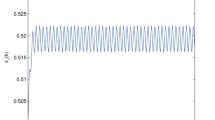Abstract
The stability criterion used in the following is “permanence”. Permanence means that all trajectories starting in the interior are ultimately bounded away from the boundary and that this bound is independent of the initial values. Hence sufficiently small fluctuations cannot lead to extinction of any species. In the following we deal with one-prey, two-predator resp. one-prey, three-predator systems and a one-prey, two-predator, one-top-predator system with three trophic levels. It turns out that the characterization of permanence for such models described by Lotka-Volterra dynamics is rather simple and elegant.
Similar content being viewed by others
References
Amann, E., Hofbauer, J.: Permanence in Lotka-Volterra equations. In: Lotka-Volterra Approach in Dynamic Systems, Proceedings Conference Wartburg, DDR, 1984
Arneodo, A., Coullet, P., Peyraud, J., Tresser, C.: Strange attractors in Volterra equations for species in competition. J. Math. Biol. 14, 153–157 (1982)
Bazykin, A. D.: Mathematical biophysics of interacting populations (in Russian). Moscow: Nauka 1985
Butler, G., Freedman, H. I., Waltman, P.: Uniformly persistent systems. Proc. Am. Math. Soc. 96, 425–430 (1986)
Coste, J., Peyraud, J., Coullet, P.: Asymptotic behaviours in the dynamics of competing species. SIAM J. Appl. Math. 36, 516–543 (1979)
Dowker, Y. N., Friedlander, F. G.: On limit sets in dynamical systems. Proc. Lond. Math. Soc. 4, 168–176 (1954)
Franke, J. E., Selgrade, J. F.: Abstract ω-limit sets, chain recurrent sets, and basic sets for flows. Proc. Am. Math. Soc. 60, 309–316 (1976)
Freedman, H. I., Waltman, P.: Mathematical analysis of some three-species food chain models. Math. Biosci. 33, 257–276 (1977)
Freedman, H. I., Waltman, P.: Persistence in models of three interacting predator-prey populations. Math. Biosci. 68, 213–231 (1984)
Freedman, H. I., Waltman, P.: Persistence in a model of three competitive populations. Math. Biosci. 73, 89–101 (1985)
Gantmacher, F. R.: Matrizenrechnung II, Spezielle Fragen und Anwendungen. Berlin: VEB Deutscher Verlag der Wissenschaften, 1971
Gard, T. C., Hallam, T. G., Svoboda, L. J.: Persistence and extinction in three species Lotka-Volterra competitive systems. Math. Biosci. 46, 117–124 (1979)
Gard, T. C., Hallam, T. G.: Persistence in food webs I: Lotka-Volterra food chains. Bull. Math. Biol. 41, 877–891 (1979)
Gard, T. C.: Persistence in food chains with general interactions. Math. Biosci. 51, 165–174 (1980)
Gilpin, M. E.: Spiral chaos in a predator-prey model. Am. Nat. 113, 306–308 (1979)
Haigh, J., Maynard Smith, J.: Can there be more predators than prey? Theor. Popul. Biol. 3, 290–299 (1972)
Harrison, G. W.: Global stability of food chains. Am. Nat. 114, 455–457 (1979)
Hofbauer, J.: A general cooperation theorem for hypercycles. Monatsh. Math. 91, 233–240 (1981)
Hofbauer, J.: On the occurrence of limit cycles in the Volterra-Lotka equation. Nonlinear Anal., Theory Methods Appl. 5, 1003–1007 (1981)
Hofbauer, J.: Saturated equilibria, permanence, and stability for ecological systems. To appear in: Proceedings on the Second Autumn Course on Mathematical Ecology, Trieste, 1986
Hofbauer, J., Hutson, V., Jansen, W.: Coexistence for systems governed by difference equations of Lotka-Volterra type. J. Math. Biol. 25, 553–570 (1987)
Hofbauer, J., Sigmund, K.: Permanence for replicator equations. Math. of Dynamic Proc., Proc. Conf. Sopron 1985. Lect. Notes Econ. Math., vol. 287. Berlin Heidelberg New York: Springer 1987
Hofbauer, J., Sigmund, K.: Dynamical systems and theory of evolution. Cambridge: University Press 1988
Hsu, S. B., Hubbell, S. P.: Two predators competing for two prey species: An analysis of MacArthur's model. Math. Biosci. 47, 143–171 (1979)
Hutson, V., Vickers, G. T.: A criterion for permanent coexistence of species, with an application to a two-prey, one-predator system. Math. Biosci. 63, 253–269 (1983)
Jansen, W.: A permanence theorem on replicator systems. J. Math. Biol. 25, 411–422 (1987)
Kirlinger, G.: Permanence in Lotka-Volterra equations. Linked prey-predator systems. Math. Biosci. 82, 165–191 (1986)
Koch, A.: Competitive coexistence of two predators utilizing the same prey under constant environmental conditions. J. Theor. Biol. 44, 387–395 (1974)
Kostizin, V. A.: Biologie mathématique (in French). Collection Armand Colin, Paris, 1937
McGehee, R., Armstrong, R. A.: Some mathematical problems concerning the ecological principle of competitive exclusion. J. Differ. Equations 23, 30–52 (1977)
May, R. M., Leonard, W. J.: Nonlinear aspects of competition between three species. SIAM J. Appl. Math. 29, 243–253 (1975).
Rescigno, A.: The struggle for life-IV. Two predators sharing a prey. Bull. Math. Biol. 39, 179–185 (1977)
Schuster, P., Sigmund, K., Wolff, R.: Dynamical systems under constant organisation III, cooperative and competitive behaviour of hypercycles. J. Differ. Equations 32, 357–368 (1979)
Sigmund, K., Schuster, P.: Permanence and uninvadability for deterministic population models. In: Stochastic Phenomena and chaotic behaviour in complex systems. Synergetics 21, Berlin Heidelberg New York: Springer 1984
So, J. W. H.: A note on the global stability and bifurcation phenomenon of a Lotka-Volterra food chain. J. Theor. Biol. 80, 185–187 (1979)
Svirezhev, Yu. M., Logofet, D. O.: Stability of biological communities, pp. 302. Moscow: Mir Publishers 1983
Svirezhev, Yu. M., Logofet, D. O.: Complicated dynamics in simple models of ecological systems. In: Lotka-Volterra Approach in Dynamic Systems, Proceedings Conference Wartburg, DDR, 1984
Svirezhev, Yu. M.: Modern problems of mathematic ecology. Proceedings of the International Congress of Mathematics, Warsaw, 1983
Takeuchi, Y., Adachi, N.: Existence and bifurcation of stable equilibrium in two-prey, one-predator communities. Bull. Math. Biol. 45, 877–900 (1983)
Takeuchi, Y., Adachi, N.: Oscillations in prey-predator Volterra models. In: Freedman, H. I., Strobeck, C. (eds.) Population biology. Lect. Notes Biomath., vol. 52, pp. 320–326. Berlin Heidelberg New York: Springer 1983
Vance, R. R.: Predation and resource partitioning in one predator-two prey model communities Am. Nat. 112, 797–813 (1978)
Author information
Authors and Affiliations
Rights and permissions
About this article
Cite this article
Kirlinger, G. Permanence of some ecological systems with several predator and one prey species. J. Math. Biology 26, 217–232 (1988). https://doi.org/10.1007/BF00277734
Revised:
Issue Date:
DOI: https://doi.org/10.1007/BF00277734




